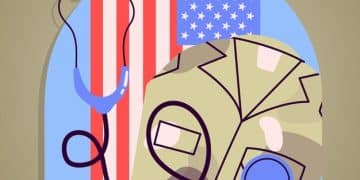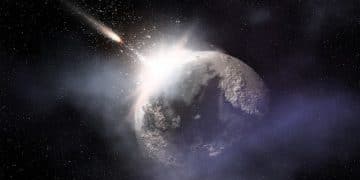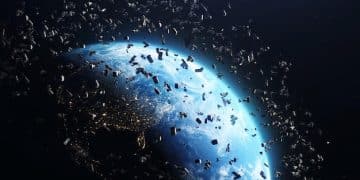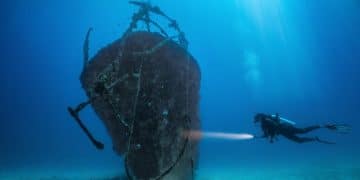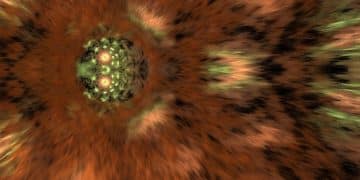The Impact of Microplastics on US Coastal Waters: A Comprehensive Study
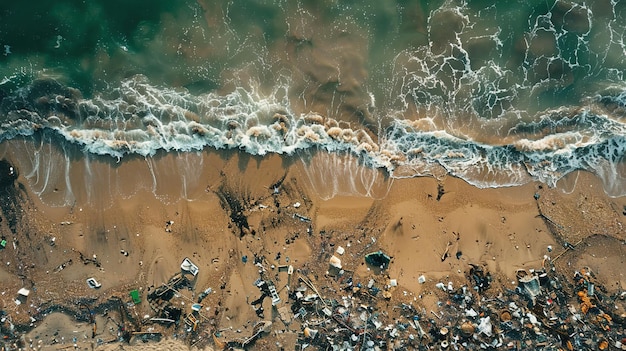
The Impact of Microplastics on Marine Ecosystems: A Comprehensive Study of US Coastal Waters reveals the pervasive threat these particles pose to marine life and coastal environments. Understanding the sources, distribution, and ecological consequences is crucial for effective mitigation strategies.
The pervasive presence of plastic pollution in our oceans has raised significant concerns about its impact on marine life and human health. Among the various forms of plastic pollution, microplastics—tiny plastic particles less than 5 millimeters in size—have emerged as a particularly insidious threat. This article delves into the Impact of Microplastics on Marine Ecosystems: A Comprehensive Study of US Coastal Waters, examining the sources, distribution, and ecological consequences of these pollutants.
By understanding the complexities of microplastic pollution, we can work towards developing effective strategies to mitigate its impact and protect the health of our oceans.
Understanding Microplastics: Sources and Pathways in US Coastal Waters
Microplastics originate from various sources, including the breakdown of larger plastic debris, industrial processes, and everyday consumer products. Understanding these sources is crucial for addressing the Impact of Microplastics on Marine Ecosystems: A Comprehensive Study of US Coastal Waters.
Primary and Secondary Microplastics
Microplastics are generally classified into two categories: primary and secondary. Primary microplastics are manufactured as small particles for use in products like cosmetics and industrial abrasives. Secondary microplastics, on the other hand, result from the fragmentation of larger plastic items, such as plastic bags, bottles, and fishing gear.
Both types contribute to the growing problem of microplastic pollution in US coastal waters.
- Wastewater Treatment Plants: These facilities are not always equipped to remove tiny plastic particles effectively, leading to microplastics being discharged into rivers and coastal waters.
- Agricultural Runoff: Plastic mulch and other agricultural plastics can break down into microplastics, which are then carried into waterways by rainwater and irrigation.
- Atmospheric Deposition: Microplastics can also be transported through the air and deposited into coastal waters through rainfall and dry deposition.
Identifying and controlling these sources are essential steps in mitigating the impact of microplastics on marine ecosystems.
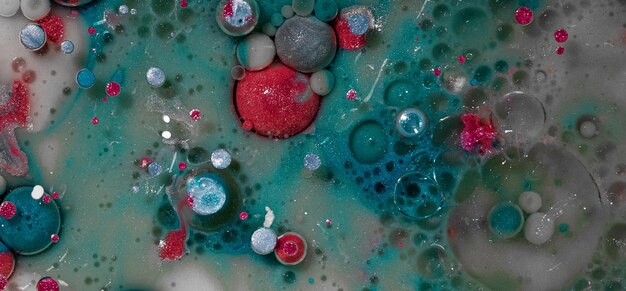
Distribution of Microplastics in US Coastal Environments
Microplastics are not uniformly distributed throughout US coastal waters. Their distribution is influenced by factors such as ocean currents, wind patterns, and proximity to urban and industrial areas. Understanding these distribution patterns is key to assessing the Impact of Microplastics on Marine Ecosystems: A Comprehensive Study of US Coastal Waters.
Hotspots of Microplastic Accumulation
Certain coastal areas tend to accumulate higher concentrations of microplastics due to specific environmental conditions and human activities. For example, enclosed bays and estuaries with limited water exchange can trap microplastics, leading to elevated levels of pollution.
Additionally, areas near densely populated cities and industrial discharge points often experience higher microplastic concentrations.
- Sampling Methods: Researchers use various methods to collect microplastics from water, sediment, and marine organisms, including net trawls, filtration systems, and sediment coring.
- Polymer Identification: Advanced analytical techniques, such as spectroscopy and mass spectrometry, are used to identify the types of plastics present in environmental samples.
- Data Analysis: Statistical models and mapping techniques are employed to analyze the spatial distribution and temporal trends of microplastic pollution.
These efforts provide valuable insights into the complex dynamics of microplastic pollution in US coastal environments.
Ecological Consequences for Marine Life
The presence of microplastics in marine ecosystems poses numerous threats to marine organisms, ranging from small invertebrates to large marine mammals. Assessing these threats is crucial for understanding **the Impact of Microplastics on Marine Ecosystems: A Comprehensive Study of US Coastal Waters**.
Ingestion and Bioaccumulation
Many marine animals, including filter feeders like shellfish and zooplankton, can ingest microplastics unintentionally. Once ingested, microplastics can accumulate in the digestive system and other tissues, leading to physical harm and potential chemical exposure.
Additionally, microplastics can act as vectors for transporting harmful pollutants and pathogens, further exacerbating their ecological impact.
- Reduced Feeding Efficiency: Microplastics can interfere with the ability of marine organisms to capture and digest food, leading to reduced growth rates and reproductive success.
- Inflammation and Tissue Damage: The presence of microplastics in the digestive system can cause inflammation, tissue damage, and other adverse health effects.
- Altered Behavior: Exposure to microplastics has been shown to alter the behavior of marine organisms, including their feeding patterns, predator avoidance strategies, and social interactions.
These ecological consequences highlight the urgent need for effective strategies to mitigate the impact of microplastic pollution on marine ecosystems.

Chemical Contamination and Microplastics
Microplastics can absorb and accumulate pollutants from the surrounding environment, potentially increasing the exposure of marine organisms to harmful chemicals. This aspect of pollution is a concerning element of the Impact of Microplastics on Marine Ecosystems: A Comprehensive Study of US Coastal Waters.
Adsorption of Pollutants
Microplastics have a large surface area-to-volume ratio, which allows them to adsorb and concentrate various pollutants, including persistent organic pollutants (POPs), heavy metals, and other toxic substances. When marine organisms ingest these contaminated microplastics, they can be exposed to higher levels of pollutants than they would otherwise encounter.
The potential for microplastics to act as vectors for chemical contamination poses a significant threat to marine food webs and human health.
Transfer of Chemicals to Marine Life
When marine organisms ingest contaminated microplastics, the adsorbed pollutants can be transferred to their tissues. This process can lead to bioaccumulation, where pollutant concentrations increase as they move up the food chain. Top predators, such as marine mammals and predatory fish, are particularly vulnerable to the effects of bioaccumulation.
This chemical contamination can have a range of negative impacts, including immune system suppression, reproductive impairment, and increased susceptibility to disease.
Mitigation Strategies and Future Research
Addressing the growing problem of microplastic pollution requires a multifaceted approach, including source reduction, improved waste management, and innovative cleanup technologies. Developing and implementing these strategies is essential for mitigating the Impact of Microplastics on Marine Ecosystems: A Comprehensive Study of US Coastal Waters.
Source Reduction and Waste Management
One of the most effective ways to reduce microplastic pollution is to prevent plastic waste from entering the environment in the first place. This can be achieved through measures such as reducing single-use plastics, promoting recycling and composting, and improving waste management infrastructure.
Additionally, policies and regulations aimed at reducing plastic production and consumption can play a crucial role in addressing the root causes of microplastic pollution.
Cleanup Technologies and Innovative Solutions
While preventing plastic waste from entering the environment is a priority, it is also important to develop and implement cleanup technologies to remove existing microplastics from coastal waters. Various innovative solutions are being explored, including:
- Filtration Systems: These systems use fine filters to capture microplastics from water, either in wastewater treatment plants or directly in coastal environments.
- Bioremediation: This approach involves using microorganisms to break down or remove microplastics from the environment.
- Physical Removal: Techniques such as beach cleanups and the use of specialized nets and booms can help remove larger plastic debris that could break down into microplastics.
The Impact of Microplastics on Marine Ecosystems: A Comprehensive Study of US Coastal Waters highlights the need for further research to better understand the long-term effects of microplastic pollution and to develop more effective mitigation strategies.
| Key Point | Brief Description |
|---|---|
| 🌊Microplastic Sources | Breakdown of larger plastics, industrial discharge, consumer products. |
| 📍Distribution Hotspots | Enclosed bays, urban areas, industrial discharge points accumulate more. |
| 🐟 Ecological Impact | Ingestion by marine life, reduced feeding efficiency, tissue damage. |
| 🧪 Chemical Contamination | Microplastics adsorb pollutants, transferring them to the food chain. |
Frequently Asked Questions
Microplastics are plastic particles less than 5mm in size. They are a concern because they are easily ingested by marine life, leading to physical harm and chemical exposure.
Microplastics enter coastal waters through various pathways, including the breakdown of larger plastics, industrial discharge, wastewater treatment plants, and agricultural runoff.
This study examines sources, distribution, and ecological consequences of microplastics in US coastal waters, providing insights into mitigation strategies and the pervasive threat to marine life.
Filter feeders such as shellfish and zooplankton are particularly vulnerable, along with larger marine animals that ingest them, leading to bioaccumulation up the food chain.
Strategies include reducing single-use plastics, promoting recycling, improving waste management, implementing cleanup technologies, and supporting policies to reduce plastic production.
Conclusion
In conclusion, the Impact of Microplastics on Marine Ecosystems: A Comprehensive Study of US Coastal Waters reveals the urgent need for action to address this pervasive pollutant. By understanding the sources, distribution, and ecological consequences of microplastics, we can work towards developing effective mitigation strategies and protecting the health of our oceans.
Continued research, policy changes, and community involvement are essential for safeguarding marine life and ensuring a sustainable future for our coastal environments.

